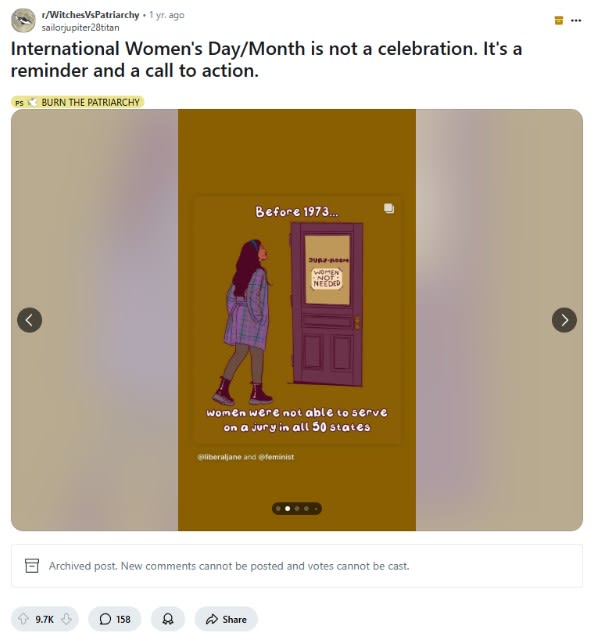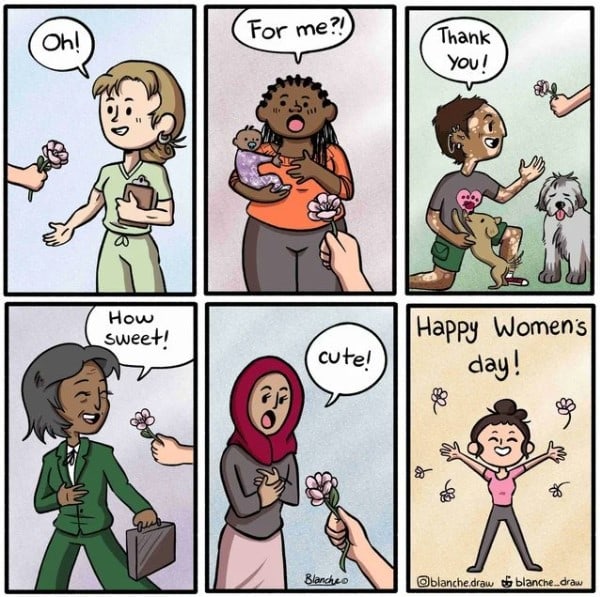View this post on InstagramA post shared by sarah bagharib (@sarahbagharib)
I’ve had enough of what International Women’s Day has become – here’s why I think it needs a reset
When I first got to know of International Women’s Day (IWD), I was in secondary school. It felt so amazing to know there was a day meant to celebrate women, shed light on the complex issues they faced daily, and support women from all walks of life in various ways.
Lately, however, that rose-tinted view is gone. Every year, as Mar 8 looms, I find myself feeling more and more exhausted by IWD.
Before you dismiss me for complaining about yet another celebratory day in the year, hear me out.
International Women’s Day began in the early 1900s. According to its website, IWD was a labour movement across North America and Europe, rallying for women’s rights at work, in politics and healthcare, and daily life.
As it spread, countries like Russia (the first to declare Mar 8 as IWD), Australia, Afghanistan, Japan, and Singapore adopted it as a movement to push for better action and awareness about the various issues women face, such as domestic violence and discriminatory work policies.
Singapore had its first IWD in 1956, when the then-Women’s League of the People’s Action Party rallied for better rights for women.
Today, the meaning of IWD has become somewhat lost.

Corporations have hijacked it, making it a day about Girl Bosses and using economic success as a metric of progress.
Some IWD events seem to further the agendas of different companies and retail brands, and many lack genuine diversity, showcasing women with the same type of background, struggles and voices. It makes the word “international” sound like a gimmick rather than a need to celebrate and advocate for all women.
And then, there are the alliterative themes that make the whole movement feel tacky – this year, it is #AccelerateAction, last year was #InspireInclusion, 2023 had #EmbraceEquity, 2022 #BreakTheBias, 2021 saw #ChooseToChallenge … you get the idea.
As a woman who wants to witness a wider range of women being truly seen, respected and celebrated – without feeling like I’m being sold an ad – I’m tired of what IWD has evolved into.
It’s time for a reset.
A CORPORATE PR OPPORTUNITY GRAB?
Lately, IWD feels like a public relations opportunity for corporations to feel good about themselves and declare: “Hey, look at us! We care about women! Go diversity!”

Cue the polished LinkedIn posts, the all-female bosses panels (when, funnily enough, female CEOs are still rare), the chocolate gifts, the (gasp) pink-themed posters, and the feel-good speeches about women’s “progress”.
The message? Women are thriving in the workplace! The reality? Many are still struggling to be heard, promoted, or supported in ways that matter.
Caregivers – most of whom are women – still struggle for more flexible work arrangements. Working mums who breastfeed resort to doing so in the toilet because lactation rooms are still rare in many offices. The gender wage gap is narrowing at a glacial pace. Women are still being underestimated by their male colleagues. And, as of the end of 2023, women made up less than 24 per cent of the boards of Singapore Exchange-listed companies, although this is improving every year.
When such issues persist, I feel companies and brands shouldn’t be patting themselves on the back and celebrating this one day for women.
Limiting crucial conversations in the workplace to one day in a year also makes the call for women’s rights tokenistic. It signals to employees, especially women, that our needs are only important on Mar 8 – when in fact, they need to be looked at every single day.

Plus, has anyone else noticed the sudden flood of sales targeting women in March?
Don’t get me wrong, I love a good discount. But what does it say when brands use IWD, a day meant to celebrate women in all our diversity, to push products that have nothing to do with empowerment or the issues that we face?
Lines like “Buy our IWD-special slimming teas to look great!”, “38 per cent off supplements that can make you strong!” or “Walk boldly in our discounted heels this IWD!” reduce the day to just another sales and marketing gimmick.
Worse, such retail promotions profit off our body issues and peddle products we don’t need, masking them as empowerment.
Even the well-meaning “Go for brunch with your girls this IWD!” meal offers ring hollow when the food and drink establishments show no real commitment to women’s issues beyond the chance to cash in on our wallets.
Sure, I’ll take the discount – but not at the cost of realising I’m not being celebrated as a woman. I’m just another sales target.
It raises the question: Has IWD become more about corporate image than actual change?
IWD SHOULD BE A DAY FOR EVERY WOMAN
When IWD becomes corporatised, a great many women’s voices get excluded.
Whenever I attend IWD panels or events, I notice a familiar pattern: Conversations often centre around corporate success – the number of women CEOs or C-suite members, girl boss entrepreneurs, and boardroom members.
Of course, women in the workforce matter. Women in leadership roles also matter – diverse leadership affects decisions and industries, after all. But should that be the only measure of success for women?

International Women’s Day is meant to celebrate women from all walks of life, yet IWD events seem to highlight the same narratives, the same success stories, and the same definitions of empowerment – most of which have to do with how many women are “killing it” at work.
This hyper-focus on women in the workforce as the only metric for women’s progress raises a myopic way of viewing gender discrimination and inequality when, in reality, it manifests differently across cultures. And so, accordingly, progress takes many forms.
Inequality and discrimination don’t just exist in the workplace. They also come in the form of domestic violence and abuse, misogyny among women themselves, and sexual harassment – in the workplace, on the internet and quite literally anywhere.
And let’s not forget how female athletes in some sports have a different dress code from their male counterparts when it comes to competition attire.
Maybe it’s time to cut down on yet another panel showcasing corporate managers. They can keep their seats, but we have to make space for a wider range of successful women – as well as view success in different ways.
While being in company leadership is admirable, not every woman wants to be a CEO, and that’s okay. If we truly care about diversity, we need to expand the conversation beyond women at work to women in all aspects of life.
A thriving society is one where women, regardless of their role, are treated with dignity, autonomy, and respect.
I’d love to see organisations shine a spotlight on the women cleaning our office pantry, artisans preserving intergenerational craft, single mums creating their own path even as they’re squeezed in a sandwich generation, abuse survivors rebuilding their lives, and volunteers at women’s shelters.
I want to hear from women who learned how to invest from scratch, advocates for the well-being of young girls in the age of social media, and aunties who care for the homeless and animals in their neighbourhoods. What are their stories? Who inspires them? Where do they find strength?
Fortunately, some organisations are shifting the narrative and doing just that.
SCAPE Singapore’s Beyond the Glass Ceiling event in February took a fresh approach. Launched in 2023, the youth-centric event gathers people from different industries to share about and discuss social issues and challenges, including gender and income inequality.
Themed BFFL (Best Friends For Life), instead of focusing solely on corporate milestones, this year’s event explored the power of friendships, mentorships, and support systems in shaping women’s lives. It featured women artists, freelancers, activists, and yes, corporate leaders, reflecting a more holistic vision of empowerment.
Another local community, Crazycat, brings women together across backgrounds, hosting events on topics from new and single motherhood to self-acceptance and career transitions.
All women, no matter their profession or experience, are welcome. Speakers range from stay-at-home mums to home-based business owners and musicians, giving insight into a variety of experiences and different forms of success that women can be inspired by.
I’d love to see organisations shining a spotlight on the women wiping our office desks, artisans preserving intergenerational craft, single mums creating their own path, abuse survivors rebuilding their lives, and volunteers at women’s shelters.
For IWD in 2023, KK Women’s and Children’s Hospital launched a women’s health guide for the various stages of life, featuring stories from women of different backgrounds battling unique health challenges. (A great step because, yes, even medical research has historically ignored women’s bodies.)
INTERNATIONAL WOMEN’S DAY CAN STAY – WITH A REFRESH
That being said, I’m all for the return of the essence of IWD.
While I think gender issues for both men and women should be discussed throughout the year, there is value in having a day to celebrate and support women – when it’s done right.
(And yes, I know International Men’s Day exists. I’m not against that either, but that’s not the topic today. By all means, let its proponents take their PR opportunities, too.)
I’m aware that addressing women’s issues every day can only exist in a perfect reality, unlike the one we live in. Let’s make the one day we have – Mar 8 – count.
So, who is IWD for? It’s not Entrepreneurs’ Day. It’s not a day for women to “catch up” to men. It’s not another Mother’s Day. And neither is it Girl Boss Day. IWD is for all women.

I think back to my teenage years, when I was becoming aware of the discrimination I faced as a young woman. I started noticing the subtle biases against me, the ways women themselves sometimes tear each other down, and how success wasn’t just about landing a high-paying job (though that’s always nice).
I remember feeling reassured that IWD existed and that organisations were pushing for better spaces for women, whether they came from the same background as me or not.
I remember the yearning to learn more from other women in other countries, getting to know their struggles, building empathy for their challenges, and admiring the way they overcame them.
I remember realising that progress doesn’t mean women have to mimic men’s achievements to prove their worth.
I remember understanding that both women and men work together for a more inclusive society. We don’t need a female Sherlock Holmes or James Bond to prove we belong. We don’t need to copy. We can create. We can celebrate what we have while demanding more.
So, yes, the corporate hijacking of IWD is everywhere – on social media, your company’s email blast, in shopping malls vying for your money.
But as I observe the different communities and organisations coming together to honour International Women’s Day, I hold on to the belief that IWD can still be relevant but with a refresh.
CNA Women is a section on CNA Lifestyle that seeks to inform, empower and inspire the modern woman. If you have women-related news, issues and ideas to share with us, email CNAWomen [at] mediacorp.com.sg.
Disclaimer: Investing carries risk. This is not financial advice. The above content should not be regarded as an offer, recommendation, or solicitation on acquiring or disposing of any financial products, any associated discussions, comments, or posts by author or other users should not be considered as such either. It is solely for general information purpose only, which does not consider your own investment objectives, financial situations or needs. TTM assumes no responsibility or warranty for the accuracy and completeness of the information, investors should do their own research and may seek professional advice before investing.
Most Discussed
- 1
- 2
- 3
- 4
- 5
- 6
- 7
- 8
- 9
- 10